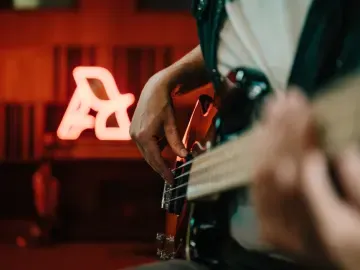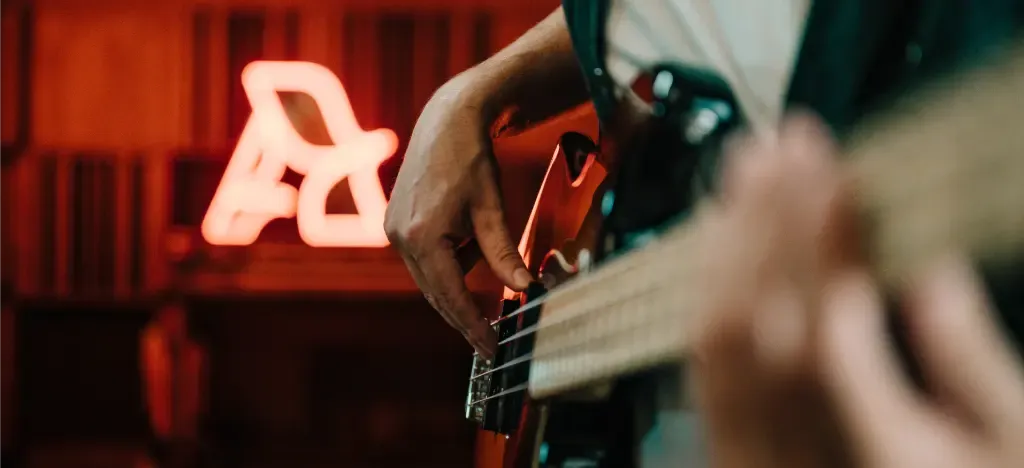When I play bass in my band, I feel a unique connection to the music that’s hard to describe. I become that deep, steady groove that holds everything together. For those just starting out, the bass guitar is a fantastic choice and allows you to jump straight into playing, playing music right from day one. This guide is your stepping stone into the world of bass guitar, complete with tips, techniques, and a free tutorial to help you get started.
- Is bass guitar easier to learn than guitar?
- Choosing the right bass guitar for beginners
- How to hold the bass guitar and finger placement
- How to tune your bass guitar
- Finding your way around the bass fretboard
- Bass playing techniques: the fingerstyle method
- Free video lesson: bass fingerstyle
- How to play bass using a pick
- Slap bass for beginners
- Common beginner bass mistakes
- Learn to play bass guitar for free!
Is bass guitar easier to learn than guitar?
For those people who are undecided, I thought I would start with this question because it comes up a lot.
The answer is both yes and no. For complete beginners who haven't played guitar, bass is easier to get started on because it usually involves playing single notes rather than chords. The focus is on rhythm and groove, which can be more straightforward but demands precise timing and consistency. So, while bass might give you a quicker start, as you get more advanced, both instruments will push you to grow as a musician in unique ways.
Apart from this, if you have a great sense of rhythm and groove, the bass guitar is perfect, really versatile across all genres, and always in high demand.
If you want to play bass, obviously you'll need one. The cheapest option would be to borrow one from a friend, but let's have a look at a few options.
Choosing the right bass guitar for beginners
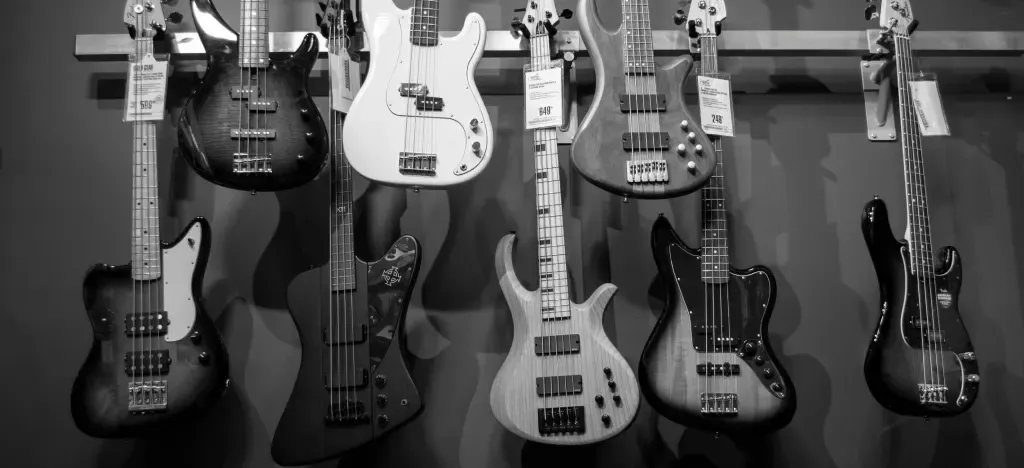
Types of bass guitars
When you’re just starting out, the 4-string bass guitar is your best bet at least until you’re more comfortable with the basics.
4-string bass: This is the most common type, covering the essential bass notes (E-A-D-G), and it's easier to play because of its narrower neck and simpler fingerboard. Perfect for learning the basics.
5-string and 6-string basses: These offer more range but can be harder to manage due to their wider necks.
Should a beginner buy an expensive bass guitar?
It’s tempting to go all out on a fancy bass, but it’s often more practical to start with a budget-friendly model.
Affordable options like the Squier Affinity Series or Yamaha TRBX174 offer great playability and sound without overwhelming you with more complex features.
Consider second-hand gear: If you're on a tighter budget, a second-hand gear is a solid option. You can find gently used basses and amps at a fraction of the cost. Just ensure you buy from reputable sellers and check the condition of the equipment before you buy.
Upgrade later: If you find yourself committed and eager to progress, you can always invest in a higher-end bass later on. These models often have better sound quality and durability, which can inspire you to practice more.
Do I need an amp to play bass?
Basically, yes, you’ll need an amp to hear the bass guitar properly.
Bass guitars produce low-frequency sounds that are hard to hear without amplification. A beginner-friendly amp, like the Fender Rumble, will help you hear your playing clearly and develop your ear and technique. Look for an amp with basic features like volume control and tone adjustment. For beginners, a small, portable combo amp is usually the best choice.
Starting with a simple setup — an affordable bass and a basic amp — means you can get learning without spending too much. Brands like Squier and Yamaha offer excellent starter packs that include everything you need — bass, amp, and accessories — making it easy to start playing right away.
How to hold the bass guitar and finger placement
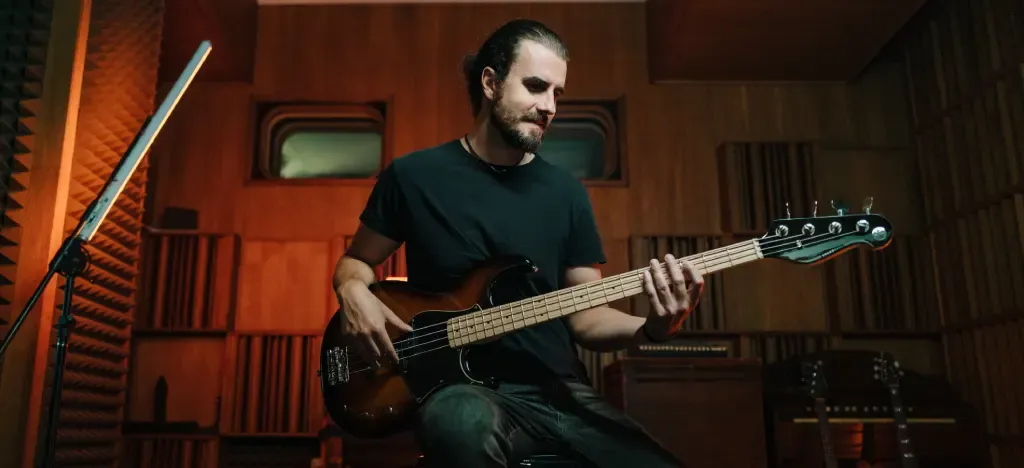
Once you have a bass, it's a good idea to focus a little on posture, to promote good habits and comfort. Probably when you are practising, you'll prefer sitting but we'll look at both:
Sitting: Sit up straight with your feet flat on the floor. Rest the bass on your right leg (if right-handed), with the neck angled slightly upwards to keep your hand and wrist in a natural position.
Standing: Adjust your strap, so the bass sits at a height where your wrist stays straight, ensuring smooth movement. The bass should feel the same whether sitting or standing.
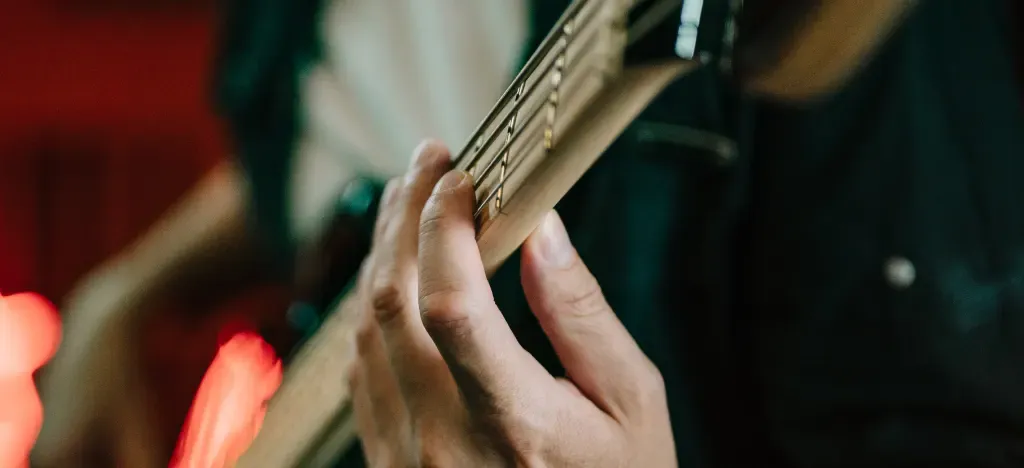 When you are sitting (or standing) comfortably:
When you are sitting (or standing) comfortably:
Rest your thumb behind the neck, opposite your index finger, for support.
Place your fingers just behind the fret for a clear sound.
Keep fingers slightly curved for even pressure and smooth transitions.
How to tune your bass guitar
Standard bass tuning
The bass guitar has four strings, each tuned to a specific note. From the lowest pitch (thickest string) to the highest pitch (thinnest string), the standard tuning is:
E — A — D — G
A fun way to remember the order is to use a mnemonic:
Enjoy A Day’s Groove
Eddie Ate Dynamite, Goodbye!
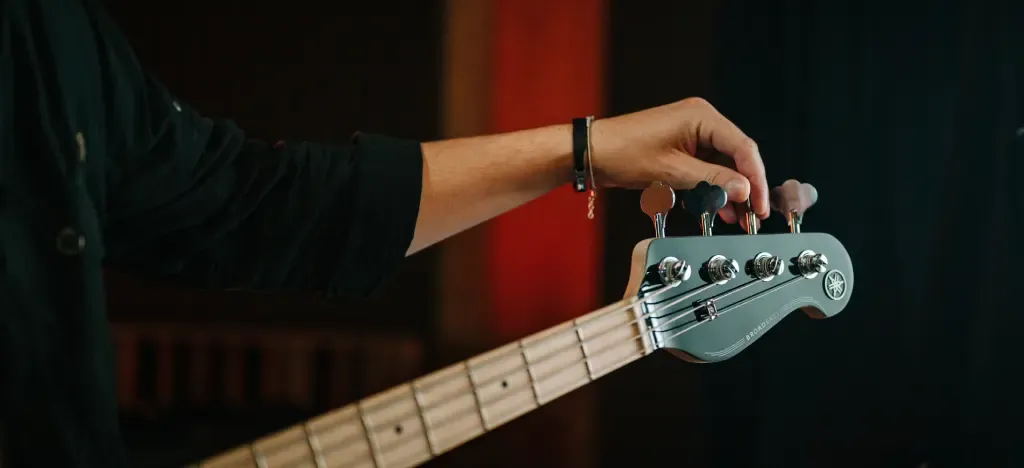 Before you actually start playing, you should always check your bass is in tune. The simplest method is to use an electronic tuner.
Before you actually start playing, you should always check your bass is in tune. The simplest method is to use an electronic tuner.
Using an electronic tuner: Turn on the tuner, play an open string, and adjust the tuning peg until the tuner indicates that the string is in tune. Repeat for all strings.
Tuning by ear: Start by tuning the E string to a reference pitch. Then, use the fifth fret method to tune the remaining strings.
Using harmonics: Play harmonics on the 5th and 7th frets to match the pitch between strings. This method helps with fine-tuning.
► ARTMASTER TIP: Find out everything you need to know about tuning in our article on how to tune a guitar, and if you don't have a tuner handy, you can always use our free online guitar tuner.
Finding your way around the bass fretboard
 As you move up the fretboard, each fret increases the pitch by a half step (or semitone). For example:
As you move up the fretboard, each fret increases the pitch by a half step (or semitone). For example:
E string (4th string): The open string is E, the first fret is F, the second fret is F#, and so on.
A string (3rd string): The open string is A, the first fret is A#, the second fret is B, etc.
Bass fingering tips
Thumb Position: Keep your thumb behind the neck, roughly aligned with your middle finger. This provides support and helps with accurate finger placement.
Finger Placement: Aim to press down just behind the fret rather than directly on it. This helps produce a clean sound without buzzing.
Introduction to scales
A great way to learn your way around the fretboard is to practise scales — the building blocks of music. Here are some basics:
Major Scale: The most fundamental scale, used in many musical styles. Example: C Major (C - D - E - F - G - A - B).
Minor Scale: Often used for music with a more serious or melancholic tone. Example: A Minor (A - B - C - D - E - F - G).
Pentatonic Scale: A versatile, five-note scale often used in blues, rock, and pop. Example: G Major Pentatonic (G - A - B - D - E).
Practice these scales slowly, focusing on finger placement and timing. As you get comfortable, increase your speed and experiment with creating your own bass lines.
► ARTMASTER TIP: Just like any skill, you need to practise. Learn how to optimise your bass practice sessions in our guide — The art of effective music practice.
Now we'll be looking at the different techniques bassists use the play the strings — fingerstyle, picking and slap.
Bass playing techniques: the fingerstyle method
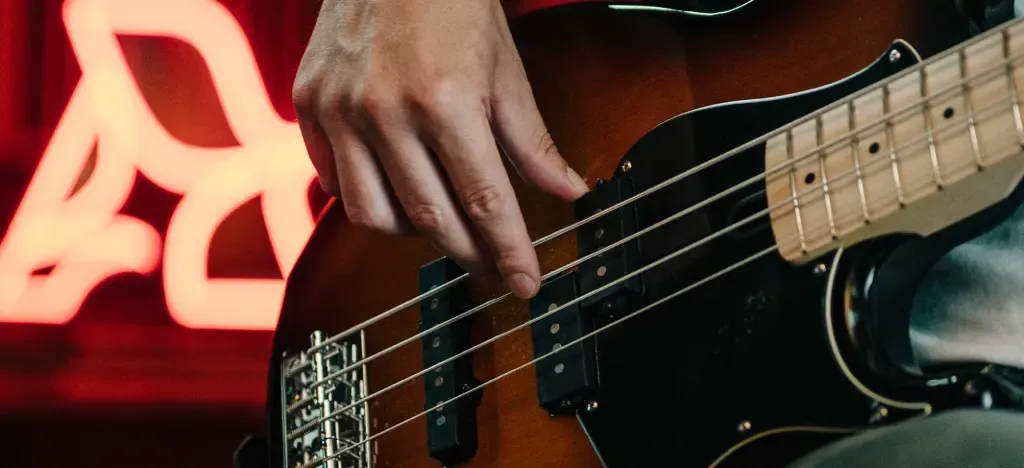 This is a basic technique that every bassist should learn.
This is a basic technique that every bassist should learn.
What’s the fingerstyle method?
The fingerstyle method involves plucking the bass strings with your fingers, typically using the index and middle fingers alternately. This technique allows for smooth, fluid bass lines and gives you great control over dynamics and tone.
How to play fingerstyle
To play fingerstyle, rest your thumb on the pickup or the E string for stability. Then, use your index and middle fingers to pluck the strings, alternating between them. Keep your fingers curved and aim to pluck the strings with the fleshy part of your fingertips for a warm, rounded tone.
Bassists who use fingerstyle
Famous bassists who use fingerstyle include James Jamerson (Motown), John Paul Jones (Led Zeppelin), and Jaco Pastorius (Weather Report). These players are known for their fluid, melodic lines that drive the rhythm section.
Free video lesson: bass fingerstyle
As I mentioned, every bassist should learn fingerstyle, whether you're into rock, jazz, or funk. In this video, professional bass teacher and author Marek Bero will show you how to pluck the strings with your fingers to create a smooth, rounded bass sound.
► ARTMASTER TIP: Start playing famous basslines quickly with London-based bass guitar teacher Marek Bero, author of the "Bass Gym" book series. In his Bass for Beginners course, Marek takes you from the basics to iconic lines all while exploring new techniques and styles. You can try it for free with our 7-day free trial.
How to play bass using a pick
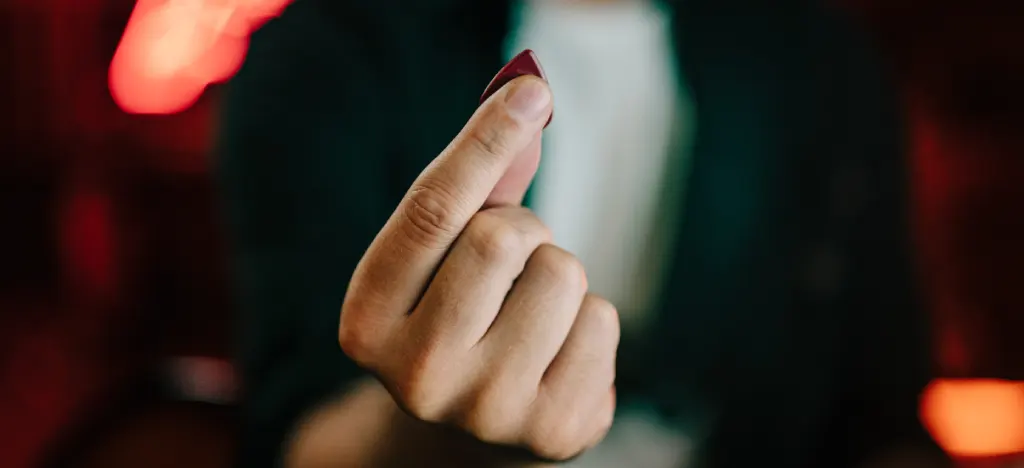 For a different sound, many bassists use a pick (plectrum). Or, like me, they are used to it from playing electric guitar.
For a different sound, many bassists use a pick (plectrum). Or, like me, they are used to it from playing electric guitar.
What’s the pick method?
The pick method involves using a plectrum (pick) to strike the bass strings, which produces a sharper, more defined sound. This technique is common in rock, punk, and metal genres.
How to play with a pick
To play with a pick, hold it between your thumb and index finger. Strike the strings using either downstrokes or alternate picking (down and upstrokes). The pick method can create a punchy, aggressive tone that cuts through the mix.
Bassists who use a pick
Notable bassists who use a pick include Paul McCartney (The Beatles), Mike Dirnt (Green Day), and Carol Kaye (session bassist). These players use the pick to create distinct, driving bass lines.
How to choose a pick
When choosing a pick, consider the thickness and material. Thicker picks produce a fuller sound, while thinner picks offer more flexibility. Common materials include nylon, celluloid, and tortex, each offering a different feel and tone.
Slap bass for beginners
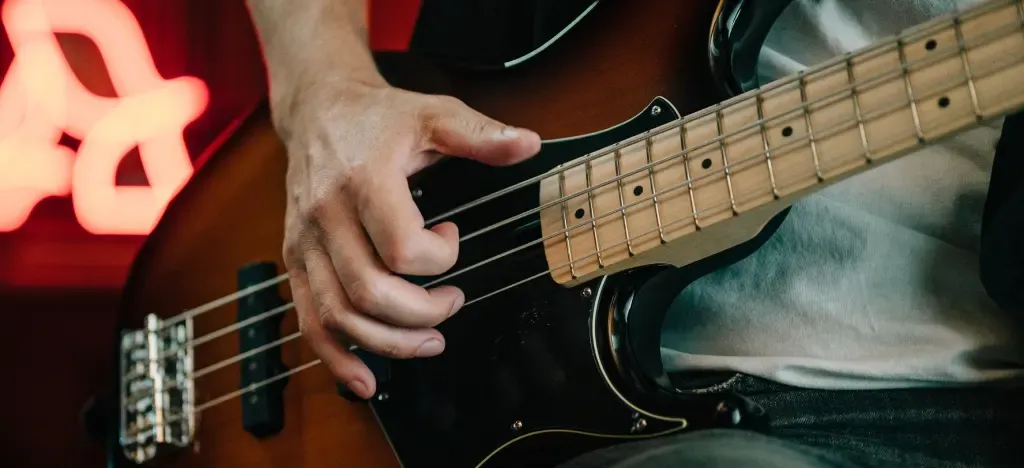
What’s the slap technique?
The slap technique is a percussive method where the thumb strikes the strings while the fingers "pop" the strings away from the fretboard. This creates a sharp, popping sound and is popular in funk, rock, and fusion.
How to slap
To slap, strike the string with the side of your thumb near the base of the nail, then quickly pull it away. To pop, hook your index or middle finger under the string and pull it away from the fretboard, letting it snap back to create a popping sound.
Bassists who slap
Famous bassists who use the slap technique include Larry Graham (Sly and the Family Stone), Flea (Red Hot Chili Peppers), and Mark King (Level 42). These bassists have popularized the slap technique with their energetic, rhythmic playing styles.
Common beginner bass mistakes
Starting out on the bass guitar is exciting, but it's easy to fall into some common traps. Knowing what to watch out for can help you avoid frustration and keep you on the right path. Here are a few of the most frequent beginner mistakes and how you can steer clear of them.
Impatience: Rushing to play complex songs can easily lead to frustration and bad habits. Focus on learning the basics and gradually build your skills for better results in the long run.
Neglecting the metronome: Timing is key to bass playing. Although it can be challenging at first, practising with a metronome helps you develop steady rhythm and consistency.
Poor left-hand technique: Gripping the neck too tightly can cause fatigue and even injury. Keep your thumb relaxed behind the neck, allowing for smooth finger movement.
Overplaying: Trying to do too much too soon often leads to sloppy playing. Focus on playing clean, precise notes instead of pushing for speed or complexity.
Not practising daily: Consistent practice is essential for improvement. Even 20-30 minutes a day helps build muscle memory and technique over time.
Ignoring other music genres: Limiting yourself to one genre restricts your development. Explore different styles to learn new techniques and become a more versatile player.
Playing alone too much: While solo practice is important, playing with others helps you learn how to lock in with the band, follow chord changes, and improve your overall musicianship.
► ARTMASTER TIP: If you really want to get a strong start on bass guitar, we recommend using a metronome from day 1. Our free online metronome is simple to use but for more tips check out our guide — How to practice with a metronome.
As you take your first steps into the world of bass guitar, remember that every great bassist started with the basics, just like you. The bass is the heartbeat of the music, the glue that holds everything together. With the tips, techniques, and free tutorial in this guide, you’re ready to start playing. Keep practising, stay patient, and soon you’ll find yourself truly connected to the music, driving the rhythm. Your bass journey begins here — let's get started!
Learn to play bass guitar for free!
If you have a bass guitar and want to start learning how to play it quickly, I really recommend Marek Bero's 'Bass for Beginners' course. You can try it for free and I guarantee you'll be grooving to some iconic tunes before the trial is up.
The trial also gives you access to all of our current courses with some of the best teachers.
Start your FREE 7-day trial today!

